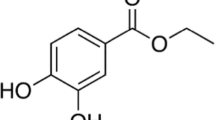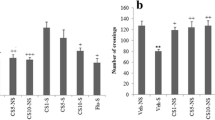Abstract
Present study was carried out to understand the possible mechanism of neuroprotective action of the root extract of Withania somnifera Dunal (WS). The study is focused on WS mediated inhibition of nitric oxide production, which is known to mediate neurodegeneration during stress. Adult mice (28 ± 5 g) were exposed to restraint stress for 30 days. Activity of NADPH diaphorase (NADPH-d) and factors (Acetylcholine, serotonin and corticosterone), which regulates NADPH-d activity were studied. Treatment with WS extract for 30 days during stress, significantly reversed the stress induced NADPH-d activation. Observations suggest that inhibition of NADPH-d by WS is not a direct effect of extract on NADPH-d, instead it inhibits via suppressing corticosterone release and activating cholineacetyltransferase, which in turn increase serotonin level in hippocampus to inhibit NADPH-d. Together, the main mechanism underlying the neuroprotective effects of WS can be attributed to its role in the down regulation of nNOS and neurochemical alterations of specific neurotransmitter systems. These observations thus suggest that WS root extract could be developed as a potential preventive or therapeutic drug for stress induced neurological disorders.



Similar content being viewed by others
References
Bone K (1996) Clinical applications of ayurvedic and Chinese herbs. Monographs for the western herbal practitioners. Phytotherapy Press, Australia, pp 137–141
Bhatnagar M, Sisodia SS, Bhatnagar R (2005) Antiulcer and antioxidant activity of Asparagus racemosus WIILD and Withania somnifera DUNN in Rats. Ann N Y Acad Sci 1056:261–278. doi:10.1196/annals.1352.027
Gupta GL, Rana AC (2007) Withania somnifera (Ashwagandha): a review. Pharmacogn Rev 1:129–136
Bhatnagar M (2009) Novel leads from herbal drugs for neurodegenerative diseases. In: Ramawat KG (ed) Herbal drugs: ethanomedicine to modern medicine. Springer-Verlag, Berlin Heidelberg, pp 221–238
Gupta SK, Dua A, Vohra BP (2003) Withania somnifera (Ashwagandha) attenuates antioxidant defense in aged spinal cord and inhibits copper induced lipid peroxidation and protein oxidative modifications. Drug Metabol Drug Interact 19:211–222
Mishra LC, Singh BB, Dagenais S (2000) Scientific basis for therapeutic use of Withania somnifera (ashwagandha): a review. Altern Med Rev 5:334–346
Elsakka M, Grigorescu E, Stanescu U et al (1990) New data referring to chemistry of Withania somnifera species. Rev Med Chir Soc Med Nat Iasi 94(2):385–387
Ganzera M, Choudhary MI, Khan IA (2003) Quantitative HPLC analysis of withanolides in Withania somnifera. Fitoterapia 74(1–2):68–76. doi:10.1016/S0367-326X(02)00325-8
Jain S, Shukla SD, Sharma K et al (2001) Neuroprotective Effects of Withania somnifera Dunn in hippocampal sub-regions of female albino rat. Phytother Res 15(6):544–548. doi:10.1002/ptr.802
Ahmad M, Saleem S, Ahmad AS et al (2005) Neuroprotective effects of Withania somnifera on 6-hydroxydopamine induced Parkinsonism in rats. Hum Exp Toxicol 24(3):137–147. doi:10.1191/0960327105ht509oa
Dhuley JN (1998) Effect of ashwagandha on lipid peroxidation in stress-induced animals. J Ethnopharmacol 60:173–178. doi:10.1016/S0378-8741(97)00151-7
Panda S, Gupta P, Kar A (1997) Protective role of Aswagandha in Cadmium induced hepato-toxicity and nephro-toxicity in male mouse. Curr Sci 72(8):546–547
Bhattacharya A, Ramanathan M, Ghosal S et al (2000) Effect of Withania somnifera glycowithanolites on iron induced hepatotoxocity in rats. Phytother Res 14:568–570. doi:10.1002/1099-1573(200011)14:7<568::AID-PTR663>3.0.CO;2-Q
Chaurasia SS, Panda S, Kar A (2000) Withania somnifera root extract in the regulation of lead-induced oxidative damage in male mouse. Pharmacol Res 41(6):663–666. doi:10.1006/phrs.1999.0634
Bhattacharya A, Ghosal S, Bhattacharya SK (2001) Anti-oxidant effect of Withania somnifera glycowithanolides in chronic footshock stress-induced perturbations of oxidative free radical scavenging enzymes and lipid peroxidation in rat frontal cortex and striatum. J Ethnopharmacol 74(1):1–6. doi:10.1016/S0378-8741(00)00309-3
Bhattacharya SK, Satyan KS, Ghosal S (1997) Antioxidant activity of glycowithanolides from Withania somnifera. Indian J Exp Biol 35(3):236–239
Prakash D, Suri S, Upadhyay G et al (2007) Total phenol, antioxidant and free radical scavenging activities of some medicinal plants. Int J Food Sci Nutr 58(1):18–28. doi:10.1080/09637480601093269
Bredt DS (1999) Endogenous nitric oxide synthesis: biological functions and pathophysiology. Free Radic Res 31(6):577–596. doi:10.1080/10715769900301161
Bredt DS, Glatt CE, Hwang PM et al (1991) Nitric oxide synthase protein and mRNA are discretely localized in neuronal populations of the mammalian CNS together with NADPH diaphorase. Neuron 7(4):615–624. doi:10.1016/0896-6273(91)90374-9
Bredt DS, Snyder SH (1992) Nitric oxide, a novel neuronal messenger. Neuron 8(1):3–11. doi:10.1016/0896-6273(92)90104-L
Vincent SR, Kimura H (1992) Histochemical mapping of nitric oxide synthase in rat brain. Neuroscience 46:755–784. doi:10.1016/0306-4522(92)90184-4
Matsushita H, Takeuchi Y, Kawata M et al (2001) Distribution of NADPHDiaphorase positive neurons in the mouse brain: differences from previous finding in the rat brain and comparison with the distribution of serotonergic neurons. Acta Histochem Cytochem 34(4):235–257. doi:10.1267/ahc.34.235
Lev-Ram V, Jiang T, Wood J et al (1997) Synergies and coincidence requirements between NO, cGMP and Ca2+ in the induction of cerebellar long term depression. Neuron 18:1025–1038. doi:10.1016/S0896-6273(00)80340-2
Hawkins RD, Son H, Arancio O (1998) Nitric oxide as a retrograde messenger during long-term potentiation in hippocampus. Prog Brain Res 118:155–172. doi:10.1016/S0079-6123(08)63206-9
Iadecola C (1993) Regulation of the cerebral microcirculation during neural activity: is nitric oxide the missing link? Trends Neurosci 16:206–214. doi:10.1016/0166-2236(93)90156-G
Rigaud-Monnet AS, Heron A, Seylaz J et al (1995) Effect of inhibiting NO synthesis on hippocampal extracellular glutamate concentration in seizures induced by kainic acid. Brain Res 673:297–303. doi:10.1016/0006-8993(94)01446-O
Rigaud-Monnet AS, Pinard E, Borredon J et al (1994) Blockade of nitric oxide synthesis inhibits hippocampal hyperemia in kainic acid induced seizures. J Cereb Blood Flow Metab 14:581–590
McLeod TM, Lopez-Feguero AL, Lopez-Feguero MO (2001) Nitric oxide, stress and depression. Psychopharmacol Bull 35(1):24–41
Kashihara K, Akiyama K, Kodama M et al (2000) Temporal changes in expression of neuronal nitric oxide synthase mRNA in the rat hippocampus associated with kainate-induced seizures. Neurol Res 22(4):409–412
De Oliveira RMW, Deakin JF, Guimaraes FS (2000) Neuronal nitric oxide synthase (NOS) expression in the hippocampal formation of patients with schizophrenia and affective disorder. J Psychopharmacol 14:8
Molina JA, Jimenez-Jimenez FJ, Orti-Pareja M et al (1998) The role of nitric oxide in neurodegeneration: potential for pharmacological intervention. Drugs Aging 12:251–259. doi:10.2165/00002512-199812040-00001
Beckman JS, Koppenol WH (1996) Nitric oxide, superoxide, and peroxynitrite: the good, the bad, and ugly. Am J Physiol 271:C1424–C1437
Stamler JS (1994) Redox signaling: nitrosylation and related target interactions of nitric oxide. Cell 78:931. doi:10.1016/0092-8674(94)90269-0
Garthwaite J, Charles SL, Williams RC (1988) Endothelium-derived relaxing factor release on activation of NMDA receptor suggests role as intercellular messenger in the brain. Nature 336:385. doi:10.1038/336385a0
Harvey BH, Retief R, Korff A et al (2006) Increased hippocampal nitric oxide synthase activity and stress responsiveness after imipramine discontinuation: role of 5HT 2A/C receptors. Metab Brain Dis 21:211–220. doi:10.1007/s11011-006-9018-1
Dawson VL, Dawson TM, London ED et al (1991) Nitric oxide mediates glutamate toxicity in primary cortical cultures. Proc Natl Acad Sci USA 88:6368. doi:10.1073/pnas.88.14.6368
Dawson VL, Kizushi VM, Huang PL et al (1996) Resistance to neurotoxicity in cortical cultures from neuronal nitric oxide synthase-deficient mice. J Neurosci 16:2479
Huang Z, Huang PL, Panahian N et al (1994) Effects of cerebral ischemia in mice deficient in neuronal nitric oxide synthase. Science 265:1883. doi:10.1126/science.7522345
Paxinos G, Franklin KBJ (2001) The mouse brain in stereotaxic coordinates. Academic Press, San Diego
Udenfriend S, Weissbach H, Clark CT (1955) The estimation of 5-hydroxytryptamine (serotonin) in biological tissues. J Biol Chem 215:337–344
Joca SR, Guimaraes FS (2006) Inhibition of neuronal nitric oxide synthase in the rat hippocampus induces antidepressant like effects. Psychopharmacology (Berl) 185:298–305. doi:10.1007/s00213-006-0326-2
Matsushita H, Takeuchi Y, Kawata M et al (2001) Distribution of NADPH Diaphorase positive neurons in the mouse brain: differences from previous finding in the rat brain and comparison with the distribution of serotonergic neurons. Acta Histochem Cytochem 34(4):235–257. doi:10.1267/ahc.34.235
Bohme GA, Bon C, Lemaire M et al (1993) Altered synaptic plasticity and memory formation in nitric oxide synthase inhibitor-treated rats. Proc Natl Acad Sci USA 90:9191–9194. doi:10.1073/pnas.90.19.9191
Prast H, Philippu A (2001) Nitric oxide as modulator of neuronal function. Prog Neurobiol 64:51–68. doi:10.1016/S0301-0082(00)00044-7
Snyder SH, Ferris CD (2000) Novel neurotransmitters and their neuropsychiatric relevance. Am J Psychiatry 157:1738–1751. doi:10.1176/appi.ajp.157.11.1738
Sánchez F, Moreno MN, Vacas P et al (1999) Swim stress enhances the NADPH-diaphorase histochemical staining in the paraventricular nucleus of the hypothalamus. Brain Res 828:159–162. doi:10.1016/S0006-8993(99)01295-0
Echeverry MB, Guimarães FS, Del Bel EA (2004) Acute and delayed restraint stress-induced changes in nitric oxide producing neurons in limbic regions. Neuroscience 125(4):981–993. doi:10.1016/j.neuroscience.2003.12.046
Kishimoto J, Tsuchiya T, Emson PC et al (1996) Immobilization induced stress activates neuronal nitric oxide synthase (nNOS) mRNA and protein in hypothalamic-pitutary-adrenal axis in rats. Brain Res 720:159–171
Masood A, Banerji B, Vijayan VK et al (2004) Pharmacological and biochemical studies on the possible role of nitric oxide in stress adaptation in rats. Eur J Pharmacol 493:1111–1115
Okere CO, Waterhouse BD (2006) Acute restraint increases NADPH-diaphorase staining in distinct subregions of the rat dorsal raphe nucleus: implications for raphe serotonergic and nitrergic transmission. Brain Res 1119:174–181
Lowy MT, Gault L, Yamamoto BK (1993) Adrenalectomy attenuates stress induced elevations in extracellular glutamate concentrations in the hippocampus. J Neurochem 61(5):1957–1960. doi:10.1111/j.1471-4159.1993.tb09839.x
Sapolsky RM, Krey LC, Mcewen BS (1984) Glucocorticoid-sensitive hippocampal neurons are involved in terminating the adrenocortical stress response. Proc Natl Acad Sci USA 81:6174–6177. doi:10.1073/pnas.81.19.6174
Meaney MJ, Viau V, Aitken DH et al (1988) Stress-induced occupancy and translocation of hippocampal glucocorticoid receptors. Brain Res 445(1):198–203
Marchi M, Raiteri M (1989) Interaction acetylcholine-glutamate in rat hippocampus: involvement of two subtypes of M-2 muscarinic receptors. J Pharmacol Exp Ther 248(3):1255–1260
Campbell S, Macqueen G (2004) The role of the hippocampus in the pathophysiology of major depression. J Psychiatry Neurosci 29:417–426
McEwen BS, Magarinos AM, Reagan LP (2002) Structural plasticity and tianeptine: cellular and molecular targets. Eur Psychiatry 17 (suppl 3):318–330. doi:10.1016/S0924-9338(02)00650-8
Schliebs R, Liebmann A, Bhattacharya SK et al (1997) Systemic administration of defined extracts from Withania somnifera (Indian ginseng) and Shilajit differentially affects cholinergic but not glutamatergic and gabaergic markers in rat brain. Neurochem Int 30(2):181–190. doi:10.1016/S0197-0186(96)00025-3
Bhattacharya SK, Kumar A, Ghosal S (1995) Effects of glycowithanolides from Withania somnifera on an animal model of Alzheimer’s disease and perturbed central cholinergic markers of cognition in rats. Phytother Res 9:110–113. doi:10.1002/ptr.2650090206
Author information
Authors and Affiliations
Corresponding author
Rights and permissions
About this article
Cite this article
Bhatnagar, M., Sharma, D. & Salvi, M. Neuroprotective Effects of Withania somnifera Dunal.: A Possible Mechanism. Neurochem Res 34, 1975–1983 (2009). https://doi.org/10.1007/s11064-009-9987-7
Received:
Accepted:
Published:
Issue Date:
DOI: https://doi.org/10.1007/s11064-009-9987-7




